Glycosaminoglycans from the Starfish Lethasterias fusca: Structures and Influence on Hematopoiesis
Abstract
1. Introduction
2. Results and Discussion
3. Materials and Methods
3.1. General Methods
3.2. Isolation of Sulfated Polysaccharides
3.3. Chemical Modification of Polysaccharide LF
3.4. Polyacrylamide Gel Electrophoresis (PAGE)
3.5. Model Monosaccharide Synthesis
3.6. Cell Model
3.7. Statistical Analysis
4. Conclusions
Supplementary Materials
Author Contributions
Funding
Institutional Review Board Statement
Data Availability Statement
Conflicts of Interest
References
- Vasconcelos, A.A.; Pomin, V.H. Marine carbohydrate-based compounds with medicinal properties. Mar. Drugs 2018, 16, 233. [Google Scholar] [CrossRef] [PubMed]
- Khotimchenko, Y. Pharmacological potential of sea cucumbers. Int. J. Mol. Sci. 2018, 19, 1342. [Google Scholar] [CrossRef]
- Lazzara, V.; Arizza, V.; Luparello, C.; Mauro, M.; Vazzana, M. Bright spots in the darkness of cancer: A review of starfishes-derived compounds and their anti-tumor action. Mar. Drugs 2019, 17, 617. [Google Scholar] [CrossRef] [PubMed]
- Kochetkov, N.K.; Smirnova, G.P. Glycolipids of marine invertebrates. Adv. Carbohydr. Chem. Biochem. 1986, 44, 387–438. [Google Scholar] [CrossRef]
- Smirnova, G.P. Gangliosides of starfishes: Variety and possible species specificity of structures. Russ. J. Mar. Biol. 1987, 1, 3–7. [Google Scholar]
- Silchenko, A.S.; Avilov, S.A.; Kalinin, V.I. Separation procedures for complicated mixtures of sea cucumber triterpene glycosides, their comparison with HPLC/MS metabolomics approach and biosynthetic interpretation of the obtained structural data. In Studies in Natural Products Chemistry. Bioactive Natural Products; Atta-ur-Rahman, F.R.S., Ed.; Elsevier: Amsterdam, The Netherlands, 2022; Volume 72, pp. 103–146. [Google Scholar] [CrossRef]
- Ivanchina, N.V.; Kicha, A.A.; Malyarenko, T.V.; Stonik, V.A. Recent studies of polar steroids from starfish: Structures, biological activities and biosynthesis. In Advances in Natural Product Discovery (Chemistry Research and Applications); Gomes, A.R., Rocha-Santos, T., Duarte, A.S., Eds.; Nova Publishers: New York, NY, USA, 2017. [Google Scholar]
- Pomin, V.H.; Mourão, P.A.S. Structure, biology, evolution and medical importance of sulfated fucans and galactans. Glycobiology 2008, 18, 1016–1027. [Google Scholar] [CrossRef]
- Pomin, V.H. Holothurian fucosylated chondroitin sulfate. Mar. Drugs 2014, 12, 232–254. [Google Scholar] [CrossRef]
- Ustyuzhanina, N.E.; Bilan, M.I.; Nifantiev, N.E.; Usov, A.I. New insight on the structural diversity of holothurian fucosylated chondroitin sulfates. Pure Appl. Chem. 2019, 91, 1065–1071. [Google Scholar] [CrossRef]
- Ustyuzhanina, N.E.; Bilan, M.I.; Nifantiev, N.E.; Usov, A.I. Structural analysis of holothurian chondroitin sulfates: Degradation versus non-destructive approach. Carbohydr. Res. 2019, 476, 8–11. [Google Scholar] [CrossRef]
- Mourão, P.A.S. Perspective on the use of sulfated polysaccharides from marine organisms as a source of new antithrombotic drugs. Mar. Drugs 2015, 13, 2770–2784. [Google Scholar] [CrossRef]
- Carvalhal, F.; Cristelo, R.R.; Resende, D.I.S.P.; Pinto, M.M.M.; Sousa, E.; Correia-da-Silva, M. Antithrombotics from the sea: Polysaccharides and beyond. Mar. Drugs 2019, 17, 170. [Google Scholar] [CrossRef]
- Salih, A.E.M.; Thissera, B.; Yaseen, M.; Hussane, A.S.I.; El-Seedi, H.R.; Sayed, A.M.; Rateb, M.E. Marine sulfated polysaccharides as promising antiviral agents: A comprehensive report and modeling study focusing on SARS CoV-2. Mar. Drugs 2021, 19, 406. [Google Scholar] [CrossRef]
- Li, Y.; Qin, J.; Cheng, Y.; Lv, D.; Li, M.; Qi, Y.; Lan, J.; Zhao, Q.; Li, Z. Marine sulfated polysaccharides: Preventive and therapeutic effects on metabolic syndrome: A review. Mar. Drugs 2021, 19, 608. [Google Scholar] [CrossRef]
- Koyota, S.; Wimalasiri, K.M.S.; Hoshi, M. Structure of the main saccharide chain in the acrosome reaction-inducing substance of the starfish, Asterias amurensis. J. Biol. Chem. 1997, 272, 10372–10376. [Google Scholar] [CrossRef]
- Zhang, W.; Wang, J.; Jin, W.; Zhang, Q. The antioxidant activities and neuroprotective effect of polysaccharides from the starfish Asterias rollestoni. Carbohydr. Polym. 2013, 95, 9–15. [Google Scholar] [CrossRef]
- Liu, Y.; Wu, X.; Wang, Y.; Jin, W.; Guo, Y. The immunoenhancement effects of starfish Asterias rollestoni polysaccharides in macrophages and cyclophosphamide-induced immunosuppression mouse models. Food Funct. 2020, 11, 10700–10708. [Google Scholar] [CrossRef] [PubMed]
- Nam, K.-S.; Kim, C.-H.; Shon, Y.-H. Breast cancer chemopreventive activity of polysaccharides from starfish in vitro. J. Microbiol. Biotechnol. 2006, 16, 1405–1409. [Google Scholar]
- Nam, K.-S.; Shon, Y.-H. Chemopreventive effects of polysaccharide extract from Asterina pectinifera on HT-29 human colon adenocarcinoma cells. BMB Rep. 2009, 42, 277–280. [Google Scholar] [CrossRef]
- Lee, K.-S.; Shin, J.-S.; Nam, K.-S. Cancer chemopreventive effects of starfish polysaccharide in human breast cancer cells. Biotechnol. Bioprocess Eng. 2011, 16, 978–991. [Google Scholar] [CrossRef]
- Lee, K.-S.; Shin, J.-S.; Nam, K.-S. Starfish polysaccharides downregulate metastatic activity through the MAPK signaling pathway in MCF-7 human breast cancer cells. Mol. Biol. Rep. 2013, 40, 5959–5966. [Google Scholar] [CrossRef] [PubMed]
- Baharara, J.; Amini, E. The potential of brittle star extracted polysaccharide in promoting apoptosis via intrinsic signaling pathway. Avicenna J. Med. Biotechnol. 2015, 7, 151–158. [Google Scholar] [PubMed]
- Ma, H.; Yuan, Q.; Tang, H.; Tan, H.; Li, T.; Wei, S.; Huang, J.; Yao, Y.; Hu, Y.; Zhong, S.; et al. Structural elucidation of a glucan from Trichaster palmiferus by its degraded products and preparation of its sulfated derivative as an anticoagulant. Mar. Drugs 2023, 21, 148. [Google Scholar] [CrossRef]
- Medeiros, G.F.; Mendes, A.; Castro, R.A.B.; Baú, E.C.; Nader, H.B.; Dietrich, C.P. Distribution of sulfated glycosaminoglycans in the animal kingdom: Widespread occurrence of heparin-like compounds in invertebrates. Biochim. Biophys. Acta 2000, 1475, 287–294. [Google Scholar] [CrossRef] [PubMed]
- Ramachandra, R.; Namburi, R.B.; Ortega-Martinez, O.; Shi, X.; Zaja, J.; Dupont, S.T.; Thorndyke, M.C.; Lindahl, U.; Spillmann, D. Brittlestars contain highly sulfated chondroitin sulfates/dermatan sulfates that promote fibroblast growth factor 2-induced cell signaling. Glycobiology 2014, 24, 195–207. [Google Scholar] [CrossRef] [PubMed]
- Ramachandra, R.; Namburi, R.B.; Dupont, S.T.; Ortega-Martinez, O.; van Kuppevelt, T.H.; Lindahl, U.; Spillmann, D. A potential role for chondroitin sulfate/dermatan sulfate in arm regeneration in Amphiura filiformis. Glycobiology 2017, 27, 438–449. [Google Scholar] [CrossRef]
- Ustyuzhanina, N.E.; Bilan, M.I.; Dmitrenok, A.S.; Tsvetkova, E.A.; Nifantiev, N.E.; Usov, A.I. Oversulfated dermatan sulfate and heparinoid in the starfish Lysastrosoma anthosticta: Structures and anticoagulant activity. Carbohydr. Polym. 2021, 261, 117867. [Google Scholar] [CrossRef]
- Smirnova, G.P.; Glukhoded, I.S.; Kochetkov, N.K. Gangliosides of the starfish Lethasterias fusca. Russ. J. Bioorg. Chem. 1986, 12, 377–382. [Google Scholar]
- Ivanchina, N.V.; Malyarenko, T.V.; Kicha, A.A.; Kalinovskii, A.I.; Dmitrenok, P.S. Polar steroidal compounds from the Far-Eastern starfish Lethasterias fusca. Russ. Chem. Bull. 2008, 57, 204–208. [Google Scholar] [CrossRef]
- Ivanchina, N.V.; Kalinovsky, A.I.; Kicha, A.A.; Malyarenko, T.V.; Dmitrenok, P.S.; Ermakova, S.P.; Stonik, V.A. Two new asterosaponins from the Far Eastern starfish Lethasterias fusca. Nat. Prod. Commun. 2012, 7, 853–858. [Google Scholar] [CrossRef]
- Popov, R.S.; Ivanchina, N.V.; Kicha, A.A.; Malyarenko, T.V.; Dmitrenok, P.S. Structural characterization of polar steroid compounds of the Far Eastern starfish Lethasterias fusca by nanoflow liquid chromatography coupled to quadrupole time-of-flight tandem mass spectrometry. J. Am. Soc. Mass Spectrom. 2019, 30, 743–764. [Google Scholar] [CrossRef]
- Popov, R.S.; Ivanchina, N.V.; Kicha, A.A.; Malyarenko, T.V.; Grebnev, B.B.; Stonik, V.A.; Dmitrenok, P.S. The distribution of asterosaponins, polyhydroxysteroids and related glycosides in different body components of the Far Eastern starfish Lethasterias fusca. Mar. Drugs 2019, 17, 523. [Google Scholar] [CrossRef] [PubMed]
- Vieira, R.P.; Mulloy, B.; Mourão, P.A.S. Structure of a fucose-branched chondroitin sulfate from sea cucumber. Evidence for the presence of 3-O-sulfo-β-D-glucuronosyl residues. J. Biol. Chem. 1991, 266, 13530–13536. [Google Scholar] [CrossRef] [PubMed]
- Pavão, M.S.G.; Aiello, K.R.M.; Werneck, C.C.; Silva, L.C.F.; Valente, A.-P.; Mulloy, B.; Colwell, N.S.; Tollefsen, D.M.; Mourão, P.A. Highly sulfated dermatan sulfates from Ascidians. Structure versus anticoagulant activity of these glycosaminoglycans. J. Biol. Chem. 1998, 273, 27848–27857. [Google Scholar] [CrossRef] [PubMed]
- Pavão, M.S.G.; Mourão, P.A.S.; Mulloy, B.; Tollefsen, D.M. A unique dermatan sulfate-like glycosaminoglycan from Ascidian. Its structure and effect of its unusual sulfation pattern on anticoagulant activity. J. Biol. Chem. 1995, 270, 31027–31036. [Google Scholar] [CrossRef]
- Bossennec, V.; Petitou, M.; Perly, B. 1H-NMR investigation of naturally occurring and chemically oversulphated dermatan sulphates. Identification of minor monosaccharide residues. Biochem. J. 1990, 267, 625–630. [Google Scholar] [CrossRef] [PubMed]
- Chen, Y.; Lin, L.; Agyecum, I.; Zhang, X.; Ange, K.S.; Yu, Y.; Linhardt, R.J. Structural analysis of heparin-derived 3-O-sulfated tetrasaccharides: Antithrombin binding site variants. J. Pharm. Sci. 2017, 106, 973–981. [Google Scholar] [CrossRef] [PubMed]
- Yates, E.A.; Santini, F.; De Cristofano, B.; Payre, N.; Cosentino, C.; Guerrini, M.; Naggi, A.; Torri, G.; Hricovini, M. Effect of substitution pattern on 1H, 13C NMR chemical shifts and 1JCH coupling constants in heparin derivatives. Carbohydr. Res. 2000, 329, 239–247. [Google Scholar] [CrossRef]
- Martin, C.E.; Weishaupt, M.W.; Seeberger, P.H. Progress toward developing a carbohydrate-conjugate vaccine against Clostridium difficile ribotype 027: Synthesis of the cell-surface polysaccharide PS-I repeating unit. Chem. Commun. 2011, 47, 10260–10262. [Google Scholar] [CrossRef]
- Cao, X.; Lv, Q.; Li, D.; Ye, H.; Yan, X.; Yang, X.; Gan, H.; Zhao, W.; Jin, L.; Wang, P.; et al. Direct C5-isomerization approach to L-iduronic acid derivatives. Asian J. Org. Chem. 2015, 4, 899–902. [Google Scholar] [CrossRef]
- Notaro, A.; Vershinin, Z.; Guan, Z.; Eichler, J.; De Castro, C. An N-linked tetrasaccharide from Halobacterium salinarum presents a novel modification, sulfation of iduronic acid at the O-3 position. Carbohydr. Res. 2022, 521, 108651. [Google Scholar] [CrossRef]
- Anisimova, N.; Ustyuzhanina, N.; Bilan, M.; Donenko, F.; Usov, A.; Kiselevskiy, M.; Nifantiev, N. Fucoidan and fucosylated chondroitin sulfate stimulate hematopoiesis in cyclophosphamide-induced mice. Mar. Drugs 2017, 15, 301. [Google Scholar] [CrossRef] [PubMed]
- Anisimova, N.Y.; Ustyuzhanina, N.E.; Bilan, M.I.; Donenko, F.V.; Ushakova, N.A.; Usov, A.I.; Kiselevskiy, M.V.; Nifantiev, N.E. Influence of modified fucoidan and related sulfated oligosaccharides on hematopoiesis in cyclophosphamide-induced mice. Mar. Drugs 2018, 16, 333. [Google Scholar] [CrossRef] [PubMed]
- Li, C.; Niu, Q.; Li, S.; Zhang, X.; Liu, C.; Cai, C.; Li, G.; Yu, G. Fucoidan from sea cucumber Holothuria polii: Structural elucidation and stimulation of hematopoietic activity. Int. J. Biol. Macromol. 2020, 154, 1123–1131. [Google Scholar] [CrossRef] [PubMed]
- Ustyuzhanina, N.E.; Bilan, M.I.; Dmitrenok, A.S.; Shashkov, A.S.; Ponce, N.M.A.; Stortz, C.A.; Nifantiev, N.E.; Usov, A.I. Fucosylated chondroitin sulfate from the sea cucumber Hemioedema spectabilis: Structure and influence on cell adhesion and tubulogenesis. Carbohydr. Polym. 2020, 234, 115895. [Google Scholar] [CrossRef] [PubMed]
- Ustyuzhanina, N.E.; Anisimova, N.Y.; Bilan, M.I.; Donenko, F.V.; Morozevich, G.E.; Yashunskiy, D.V.; Usov, A.I.; Siminyan, N.G.; Kirgisov, K.I.; Varfolomeeva, S.R.; et al. Chondroitin sulfate and fucosylated chondroitin sulfate as stimulators of hematopoiesis in cyclophosphamide-induced mice. Pharmaceuticals 2021, 14, 1074. [Google Scholar] [CrossRef]
- Bilan, M.I.; Grachev, A.A.; Ustuzhanina, N.E.; Shashkov, A.S.; Nifantiev, N.E.; Usov, A.I. Structure of a fucoidan from the brown seaweed Fucus evanescens C.Ag. Carbohydr. Res. 2002, 337, 719–730. [Google Scholar] [CrossRef]
- Bilan, M.I.; Zakharova, A.N.; Grachev, A.A.; Shashkov, A.S.; Nifantiev, N.E.; Usov, A.I. Polysaccharides of algae. 60. Fucoidan from the Pacific brown alga Analipus japonicus (Harv.) Winne (Ectocarpales, Scytosiphonaceae). Russ. J. Bioorg. Chem. 2007, 33, 38–46. [Google Scholar] [CrossRef]
- Dodgson, K.S.; Price, R.G. A note on the determination of the ester sulfate content of sulfated polysaccharides. Biochem. J. 1962, 84, 106–110. [Google Scholar] [CrossRef]
- Usov, A.I.; Bilan, M.I.; Klochkova, N.G. Polysaccharides of algae. 48. Polysaccharide composition of several calcareous red algae: Isolation of alginate from Corallina pilulifera P. et R. (Rhodophyta, Corallinaceae). Bot. Mar. 1995, 38, 43–51. [Google Scholar] [CrossRef]
- Lowry, O.H.; Rosebrough, N.J.; Farr, A.L.; Randall, R.J. Protein measurement with the Folin phenol reagent. J. Biol. Chem. 1951, 193, 265–275. [Google Scholar] [CrossRef]
- Ustyuzhanina, N.E.; Bilan, M.I.; Dmitrenok, A.S.; Tsvetkova, E.A.; Shashkov, A.S.; Stonik, V.A.; Nifantiev, N.E.; Usov, A.I. Structural characterization of fucosylated chondroitin sulfates from sea cucumbers Apostichopus japonicus and Actinopyga mauritiana. Carbohydr. Polym. 2016, 153, 399–405. [Google Scholar] [CrossRef] [PubMed]
- Ustyuzhanina, N.E.; Bilan, M.I.; Dmitrenok, A.S.; Shashkov, A.S.; Nifantiev, N.E.; Usov, A.I. The structure of a fucosylated chondroitin sulfate from the sea cucumber Cucumaria frondosa. Carbohydr. Polym. 2017, 165, 7–12. [Google Scholar] [CrossRef] [PubMed]
- Guo, X.; Condra, M.; Kimura, K.; Berth, G.; Dautzenberg, H.; Dubin, P.L. Determination of molecular weight of heparin by size exclusion chromatography with universal calibration. Anal. Biochem. 2003, 312, 33–39. [Google Scholar] [CrossRef] [PubMed]
- Dubois, M.; Gilles, K.A.; Hamilton, J.K.; Rebers, P.A.; Smith, F. Colorimetric method for determination of sugars and related substances. Anal. Chem. 1956, 28, 350–356. [Google Scholar] [CrossRef]
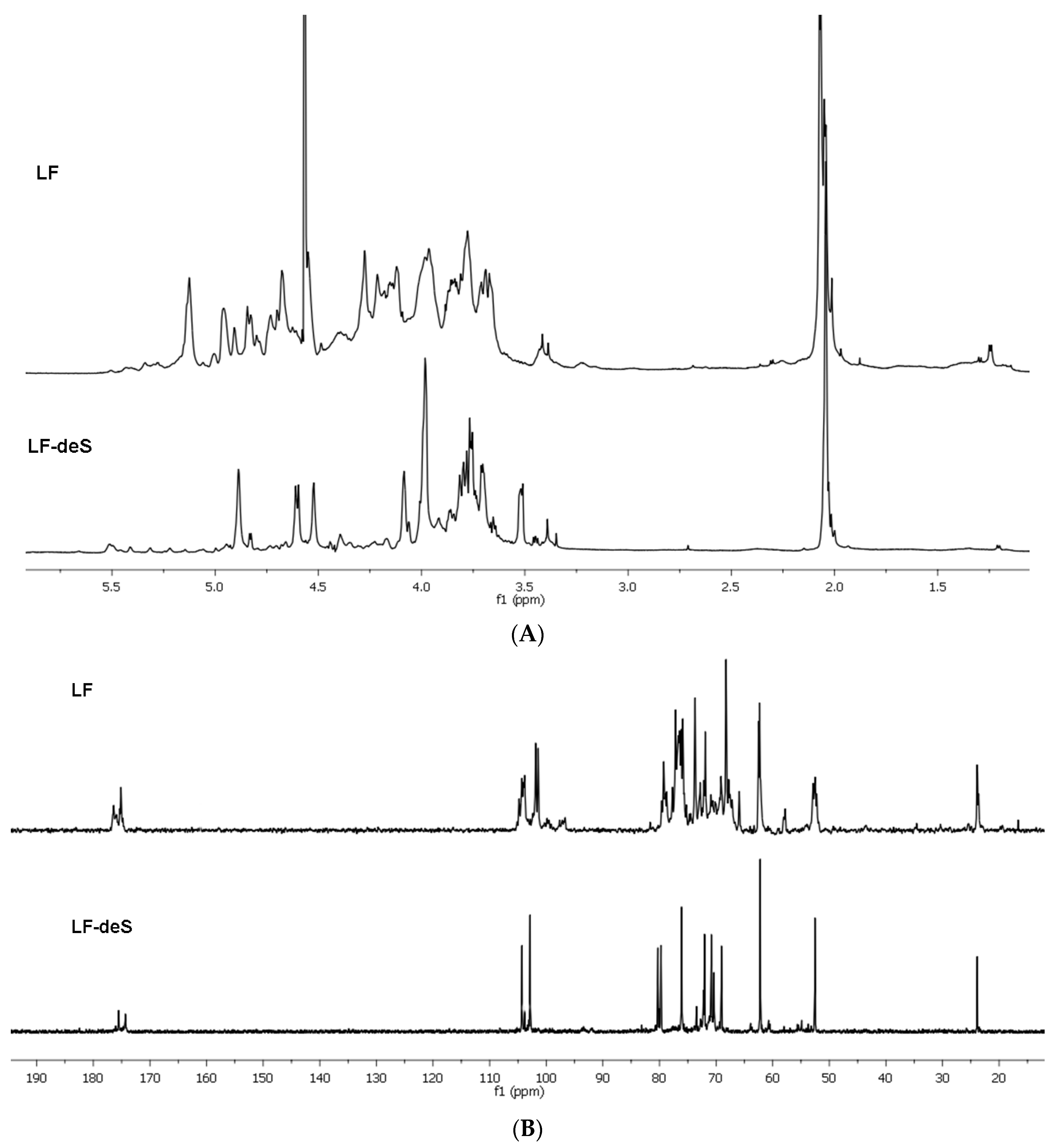
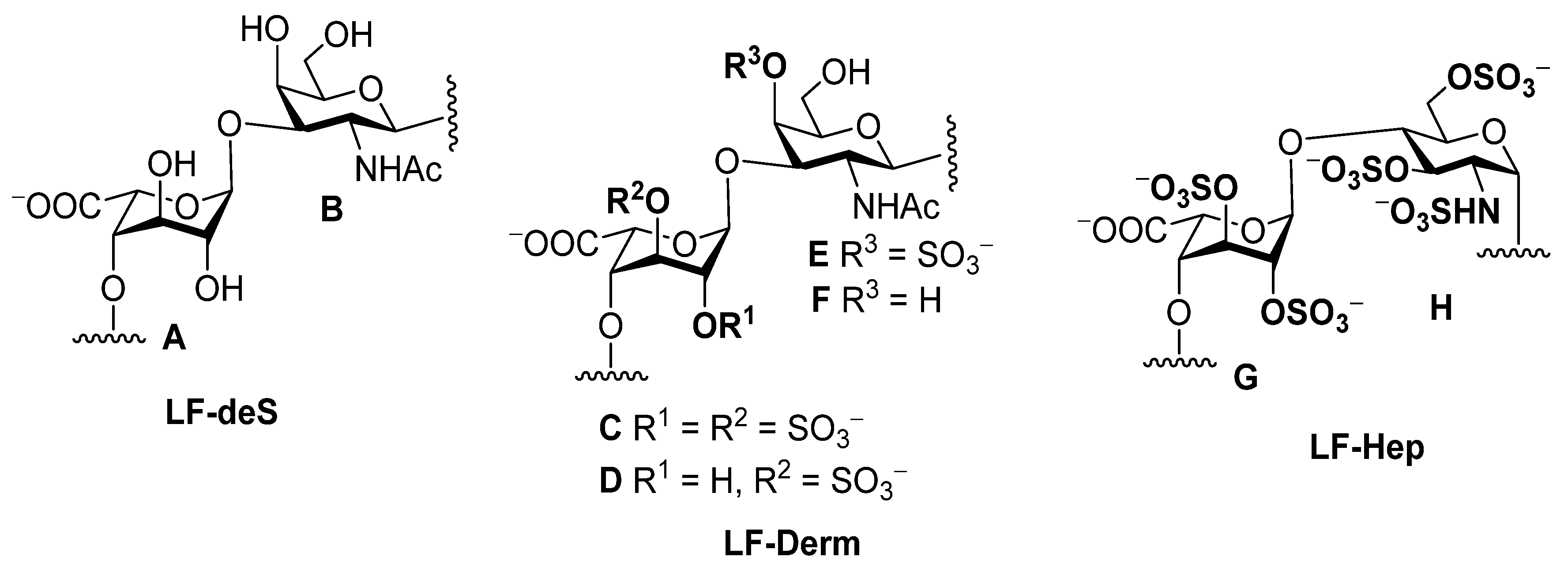
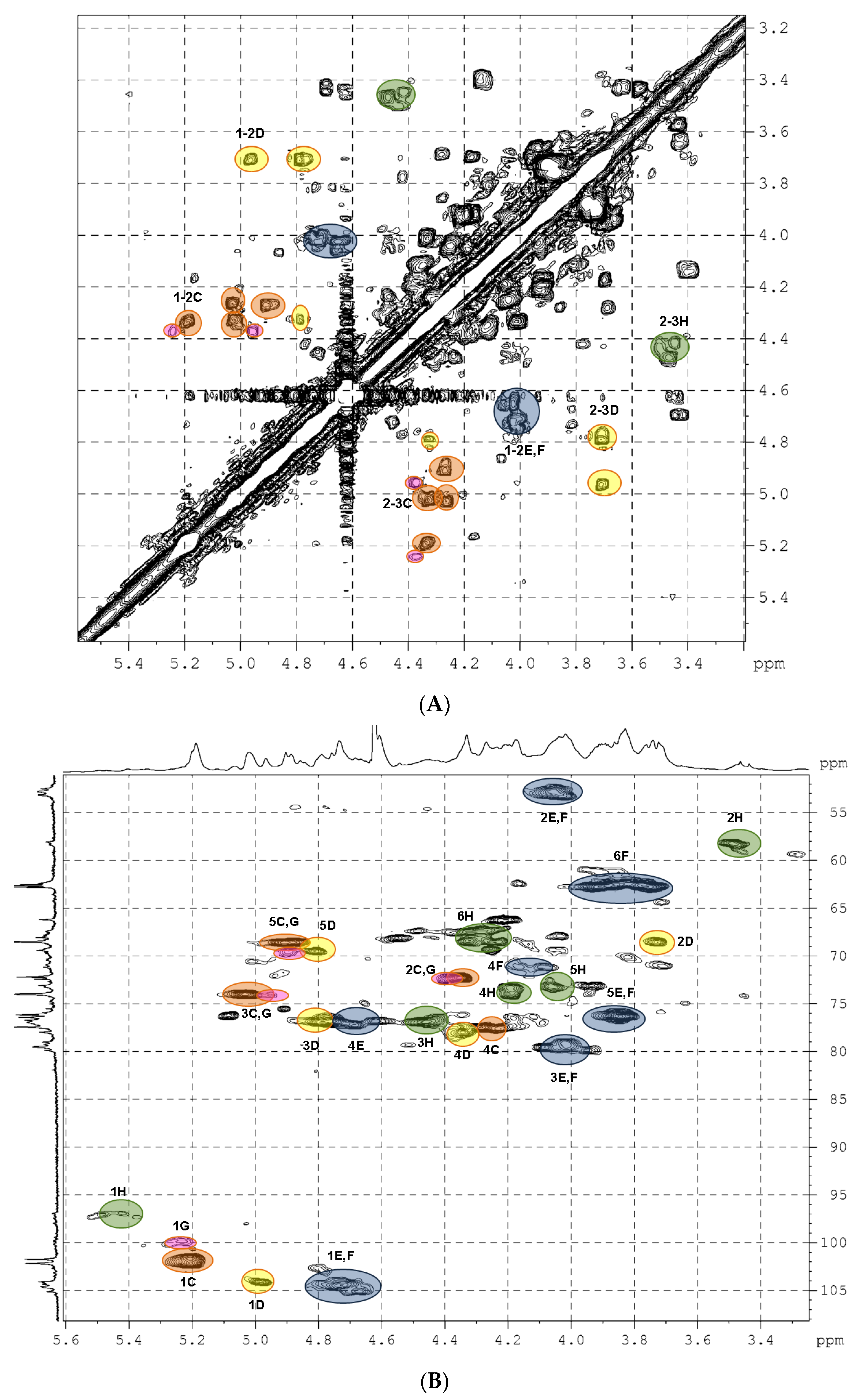
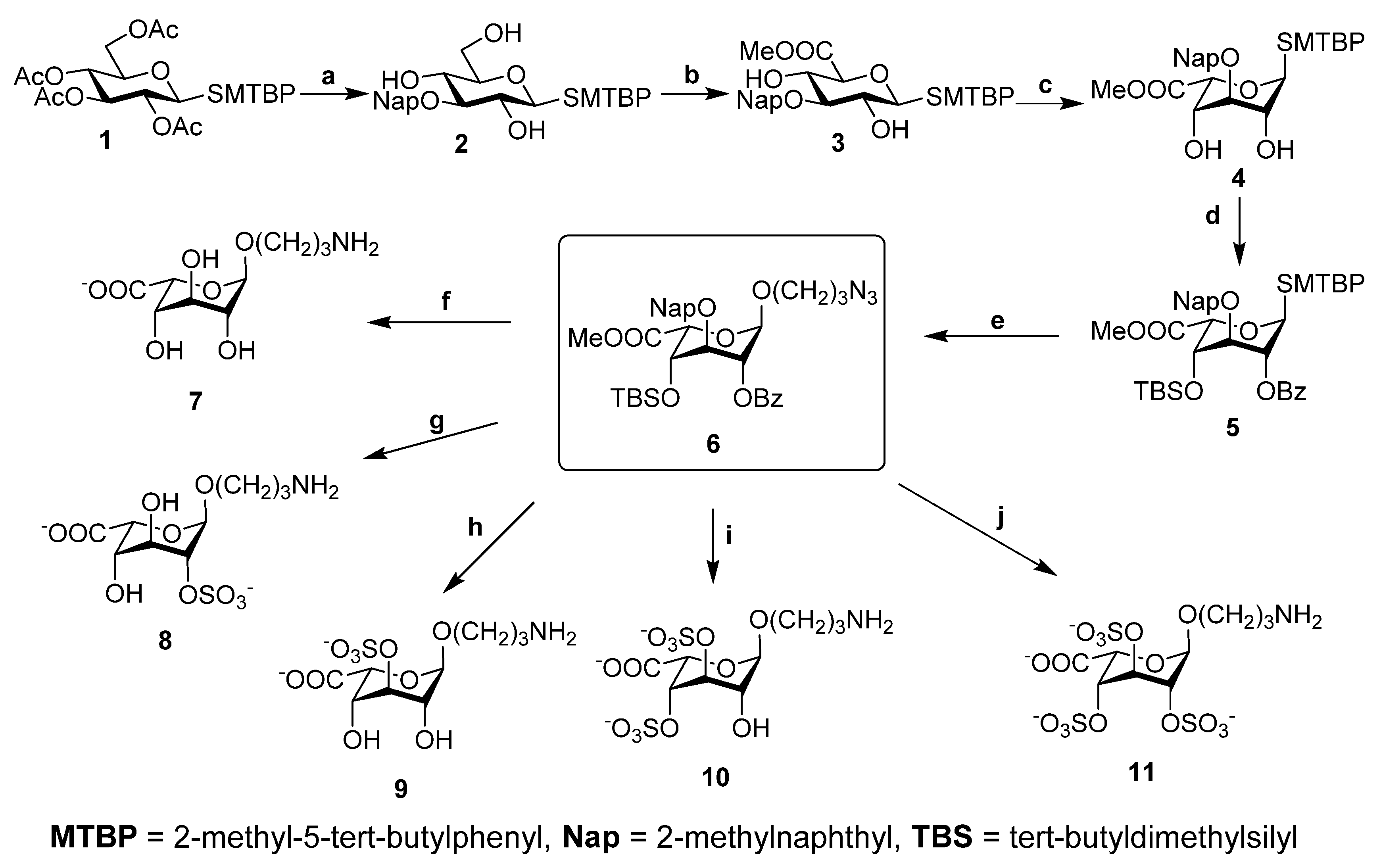

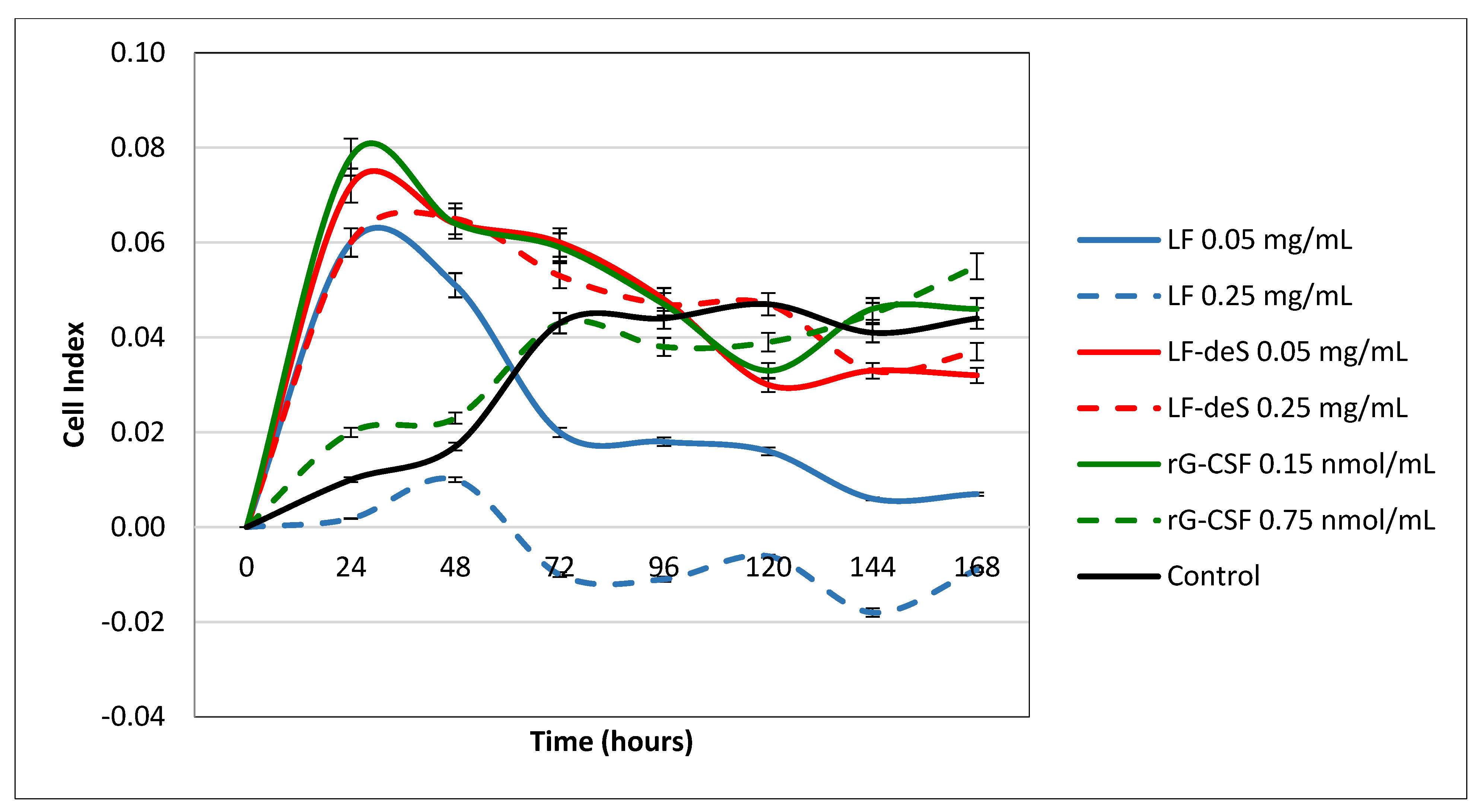
| Residue | H-1 (C-1) | H-2 (C-2) | H-3 (C-3) | H-4 (C-4) | H-5 (C-5) | H-6 (C-6) |
|---|---|---|---|---|---|---|
| A→4)-α-l-IdopA-(1→ | 4.94 | 3.57 | 4.03 | 4.13 | 4.57 | - |
| (105.0) | (71.2) | (69.5) | (80.9) | (70.8) | (176.0) | |
| B→3)-β-d-GalpNAc-(1→ | 4.58 | 3.98 | 3.79 | 3.96 | 3.68 | 3.74 |
| (103.5) | (52.8) | (80.2) | (69.5) | (76.6) | (62.5) | |
| C→4)-α-l-IdopA2S3S-(1→ | 5.20 | 4.35 | 5.00 | 4.35 | 4.93 | - |
| (101.8) | (72.0) | (73.6) | (77.2) | (68.1) | (176.0) | |
| D→4)-α-l-IdopA3S-(1→ | 4.97 | 3.72 | 4.79 | 4.35 | 4.81 | - |
| (103.8) | (68.4) | (76.7) | (76.8) | (69.5) | (176.0) | |
| E→3)-β-d-GalpNAc4S-(1→ | 4.72 | 4.05 | 4.00 | 4.70 | 3.80 | 3.76–3.83 |
| (104.3) | (52.8) | (79.2) | (76.7) | (76.2) | (62.5) | |
| F→3)-β-d-GalpNAc-(1→ | 4.72 | 4.05 | 3.82 | 4.10 | nd * | 3.76–3.83 |
| (104.3) | (52.8) | (76.2) | (71.1) | nd | (62.5) | |
| G→4)-α-l-IdopA2S3S-(1→ | 5.25 | 4.40 | 4.80 | 4.38 | 4.93 | - |
| (99.4) | (72.2) | (73.6) | (72.2) | (68.5) | (176.0) | |
| H→4)-α-d-GlcpNS3S6S-(1→ | 5.40 | 3.47 | 4.43 | 4.15 | 4.02 | 4.25–4.45 |
| (97.5) | (57.9) | (77.2) | (74.5) | (73.0) | (67.5) | |
| 7 α-l-IdopA | 4.76 | 3.46 | 3.71 | 3.84 | 4.39 | - |
| (100.8) | (71.1) | (72.2) | (71.0) | (71.0) | (176.4) | |
| 8 α-l-IdopA2S | 5.04 | 4.20 | 4.08 | 3.97 | 4.45 | - |
| (99.1) | (75.4) | (69.9) | (69.8) | (69.2) | (176.3) | |
| 9 α-l-IdopA3S | 4.81 | 3.77 | 4.38 | 4.09 | 4.28 | - |
| (100.6) | (70.0) | (75.6) | (67.9) | (68.9) | (176.4) | |
| 10 α-l-IdopA3S4S | 4.86 | 3.92 | 5.02 | 4.82 | 4.45 | - |
| (101.1) | (66.5) | (72.8) | (73.2) | (67.3) | (176.4) | |
| 11 α-l-IdopA2S3S4S | 5.01 | 4.38 | 5.03 | 4.68 | 4.38 | - |
| (98.7) | (71.2) | (71.6) | (72.4) | (67.1) | (176.4) |
Disclaimer/Publisher’s Note: The statements, opinions and data contained in all publications are solely those of the individual author(s) and contributor(s) and not of MDPI and/or the editor(s). MDPI and/or the editor(s) disclaim responsibility for any injury to people or property resulting from any ideas, methods, instructions or products referred to in the content. |
© 2023 by the authors. Licensee MDPI, Basel, Switzerland. This article is an open access article distributed under the terms and conditions of the Creative Commons Attribution (CC BY) license (https://creativecommons.org/licenses/by/4.0/).
Share and Cite
Bilan, M.I.; Anisimova, N.Y.; Tokatly, A.I.; Nikogosova, S.P.; Vinnitskiy, D.Z.; Ustyuzhanina, N.E.; Dmitrenok, A.S.; Tsvetkova, E.A.; Kiselevskiy, M.V.; Nifantiev, N.E.; et al. Glycosaminoglycans from the Starfish Lethasterias fusca: Structures and Influence on Hematopoiesis. Mar. Drugs 2023, 21, 205. https://doi.org/10.3390/md21040205
Bilan MI, Anisimova NY, Tokatly AI, Nikogosova SP, Vinnitskiy DZ, Ustyuzhanina NE, Dmitrenok AS, Tsvetkova EA, Kiselevskiy MV, Nifantiev NE, et al. Glycosaminoglycans from the Starfish Lethasterias fusca: Structures and Influence on Hematopoiesis. Marine Drugs. 2023; 21(4):205. https://doi.org/10.3390/md21040205
Chicago/Turabian StyleBilan, Maria I., Natalia Yu. Anisimova, Alexandra I. Tokatly, Sofya P. Nikogosova, Dmitriy Z. Vinnitskiy, Nadezhda E. Ustyuzhanina, Andrey S. Dmitrenok, Evgenia A. Tsvetkova, Mikhail V. Kiselevskiy, Nikolay E. Nifantiev, and et al. 2023. "Glycosaminoglycans from the Starfish Lethasterias fusca: Structures and Influence on Hematopoiesis" Marine Drugs 21, no. 4: 205. https://doi.org/10.3390/md21040205
APA StyleBilan, M. I., Anisimova, N. Y., Tokatly, A. I., Nikogosova, S. P., Vinnitskiy, D. Z., Ustyuzhanina, N. E., Dmitrenok, A. S., Tsvetkova, E. A., Kiselevskiy, M. V., Nifantiev, N. E., & Usov, A. I. (2023). Glycosaminoglycans from the Starfish Lethasterias fusca: Structures and Influence on Hematopoiesis. Marine Drugs, 21(4), 205. https://doi.org/10.3390/md21040205








